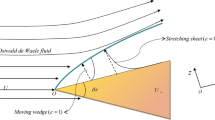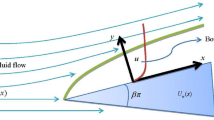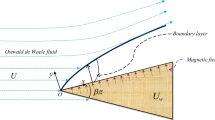Abstract
We study the stability of the two-dimensional boundary-layer flow of a power-law (Ostwald de Waele) non-Newtonian fluid over a moving wedge. The mainstream velocity is assumed to have a power of distance from the leading boundary layer, such that the system admits to the self-similar solutions. We discuss the problem in question for both shear-thickening and shear-thinning fluids which lead to a non-uniqueness (double solutions) in the base flow solutions. We then address an issue of the stability of the non-unique solutions. A linear eigenvalue analysis of the double solution reveals that the basic flow represented by the first solution is always stable, and this flow is practically encountered. The system becomes unstable to the second solutions which have the mode-two perturbations with larger boundary-layer thickness. The first and second solutions form a tongue-like structure in the solution space. Furthermore, the modification of the viscosity for the power-law fluids reveals that the system predicts an infinite viscosity in the confinement of the boundary-layer region. Extensive comparisons of the solutions with the existing models with Newtonian fluid are made, and a physical explanation behind these solutions is proposed.











Similar content being viewed by others
References
Schowalter WR (1960) The application of boundary-layer theory to power-law pseudoplastic fluids: similar solutions. AIChE J 6(1):24–28
Bird RB, Armstrong RC, Hassager O (1987) Dynamics of polymeric liquids. vol 1: Fluid mechanics. Wiley, New York
Chhabra RP (1993) Bubbles, drops and particles in non-Newtonian fluid. CRC press, Boca Raton
Andersson HI, Irgens F (1990) Film flow of power-law fluids. In: Cheremisinoff NP (ed) Encyclopedia of fluid mechanic, polymer flow engineering, vol 9. Gulf Publishing, Houston
Andersson HI, Dandapat BS (1991) Flow of a power-law over a stretching sheet. Stab Contin Media 1:339–347
Acrivos A, Shah MJ, Petersen EE (1960) Momentum and heat transfer in laminar boundary-layer flows of non-Newtonian fluids past external surfaces. AIChE J 6(2):312–317
Shah MJ (1961) PhD Thesis, University of California, Berkeley, CA
Gorla RSR, Dakappagari P, Pop I (1993) Boundary layer flow at a three-dimensional stagnation point in power-law non-Newtonian fluids. Int J Heat Fluid Flow 14(4):408–412. https://doi.org/10.1016/0142-727X(93)90015-F
Wu J, Thompson MC (1996) Non-Newtonian shear-thinning flows past a flat plate. J Non-Newtonian Fluid Mech 66:127–144
Denier JP, Dabrowski PP (2004) On the boundary layer equations for power-law fluids. Proc R Soc Lond Ser A Math Phys Eng Sci 460(2051):3143–3158
Ishak A, Nazar R, Pop I (2011) Moving wedge and flat plate in a power-law fluid. Int J Non-Linear Mech 46(8):1017–1021
Griffiths PT, Stephen SO, Basson AP, Garrett SJ (2014) Stability of the boundary layer on a rotating disk for the power-law fluids. J Non-Linear Fluid Mech 207:1–6
Griffiths PT (2017) Stability of the shear thinning boundary layer flow over a flat inclined plate. Proc R Soc Lond Ser A Math Phys Eng Sci 473(2205):20170350 (1-13). https://doi.org/10.1098/rspa.2017.0350
Longo S, Di Federico V, Chiapponi L, Archetti R (2013) Experimental verification of power-law non-Newtonian axisymmetric porous gravity currents. J Fluid Mech 731(R2):1–12. https://doi.org/10.1017/jfm.2013.389
Nouar C, Bottaro A, Brancher JP (2007) Delaying transition to turbulence in channel flow: revisiting the stability of shear-thinning fluids. J Fluid Mech 592:177–194. https://doi.org/10.1017/S0022112007008439
Nouar C, Frigaard I (2009) Stability of plane Couette-Poiseuille flow of shear-thinning fluid. Phys Fluids 21:064104. https://doi.org/10.1063/1.3152632
Ali-Benyahia K, Sbartaï Z-M, Breysse D, Kenai S, Ghrici M (2017) Analysis of the single and combined non-destructive test approaches for on-site concrete strength assessment: General statements based on a real case-study. Case Stud Constr Mater 6:109–119
Roohi R, Heydari MH, Bavi O, Emdad H (2019) Chebyshev polynomials for generalized Couette flow of fractional Jeffrey nanofuid subjected to several thermochemical effects. Eng Comput. https://doi.org/10.1007/s00366-019-00843-9
Boyd JP (2001) Chebyshev and Fourier spectral methods, 2(Revised) edn. Dover publications, Mineola
Daşçıoğlu A, Yaslan H (2011) The solution of high-order nonlinear ordinary differential equations by Chebyshev polynomials. Appl Math Comput 217(2):5658–5666
Sachdev PL, Kudenatti RB, Bujurke NM (2008) Exact analytic solution of a boundary value problem for the Falkner-Skan equation. Stud Appl Math 120(1):1–16
Kudenatti RB, Kirsur SR, Achala LN, Bujurke NM (2013) MHD boundary layer flow over a non-linear stretching boundary with suction and injection. Int J Non-Linear Mech 50:58–67
Riley N, Weidman PD (1989) Multiple solutions of the Falkner-Skan equation for a flow past a stretching boundary. SIAM J Appl Math 49(5):1350–1358
Yacob NA, Ishak A, Pop I (2011) Falkner-Skan problem for a static or moving wedge in nanofluids. Int J Therm Sci 50:133–139
Weidman PD, Kubitschek DG, Davis AMJ (2006) The effect of transpiration on self-similar boundary layer flow over moving surfaces. Int J Eng Sci 44:730–737
Sharma R, Ishak A, Pop I (2014) Stability analysis of magnetohydrodynamic stagnation-point flow toward a stretching/shrinking sheet. Comput Fluids 102:94–98
Harris SD, Ingham DB, Pop I (2009) Mixed convection boundary-layer flow near the stagnation point on a vertical surface in a porous medium: Brinkman model with slip. Transp. Porous Media 77:267–285
Abramowitz M, Stegun I (1970) Handbook of mathematical functions with formulas, graph and mathematical tables, 9th edn. Dover publications, New York
Andrews L (1998) Special functions of mathematics for engineers, 2nd edn. Oxford University Press, Oxford
Acknowledgements
Authors are grateful to the SERB (Science and Engineering Research Technology Board), New Delhi, India, for providing financial assistance under Core Research Grant (CRG/2019/004806) to carry out our work. Authors also thank the anonymous referees for their constructive comments that enhanced the quality of the paper.
Author information
Authors and Affiliations
Corresponding author
Ethics declarations
Conflict of interest
The authors declare that they have no conflict of interest.
Additional information
Publisher's Note
Springer Nature remains neutral with regard to jurisdictional claims in published maps and institutional affiliations.
Appendix
Appendix
Substituting (37) in (17)–(18) and upon linearization , we have:
with the conditions:
Using the transformations:
in (47), we get:
which has a solution:
where \(\beta = \frac{2m}{1+ (2n-1)m}\), \({\mathcal {U}}( \cdot , \cdot , \cdot )\), and \({\mathcal {L}}( \cdot , \cdot , \cdot )\) are the confluent hypergeometric function of second kind and Lauguerre function, respectively, and \(c_1\) and \(c_2\) are arbitrary constants (Abramowitz and Stegun [28] and Andrews [29]). The special functions \({\mathcal {U}}\) and \({\mathcal {L}}\) can be transformed into the confluent hypergeometric function of first kind using:
Therefore, (51) can be written utilizing (52) in original variables (49) as:
Using the first condition \(E(0) = \lambda -1\) in (53) gives:
To eliminate \(c_2\), we utilize:
for \({\hat{z}}\rightarrow \infty\) in (53) gives \(c_2 = 0\). Thus, the complete solution is:
using Kummer’s transformation, we arrive at (39). Furthermore, following Abramowitz and Stegun [28], asymptotic behavior of (56) of large \(\zeta\) can be approximated at leading order as:
where \(Z = \frac{-\zeta ^2}{2}\), and \(C_1\) and \(C_2\) are taken as appropriate constants. Or more precisely:
Accordingly, the following conclusions can be drawn from (58) that:
-
1.
At \(m=0\): the first term behaves as constant, whereas the second term decays asymptotically to zero. Hence, the combination of both these terms tends to zero for sufficiently large \(\zeta\).
-
2.
For \(m>0\): the first term diverges algebraically, while the second term decays to zero asymptotically. Furthermore, their linear combination becomes zero at large \(\zeta\).
Rights and permissions
About this article
Cite this article
Kudenatti, R.B., Noor-E-Misbah & Bharathi, M.C. Boundary-layer flow of the power-law fluid over a moving wedge: a linear stability analysis. Engineering with Computers 37, 1807–1820 (2021). https://doi.org/10.1007/s00366-019-00914-x
Received:
Accepted:
Published:
Issue Date:
DOI: https://doi.org/10.1007/s00366-019-00914-x




